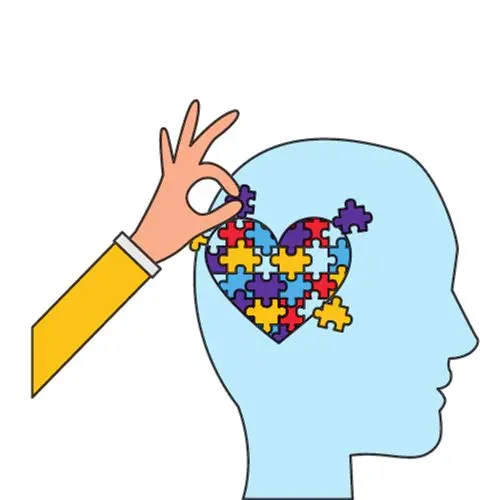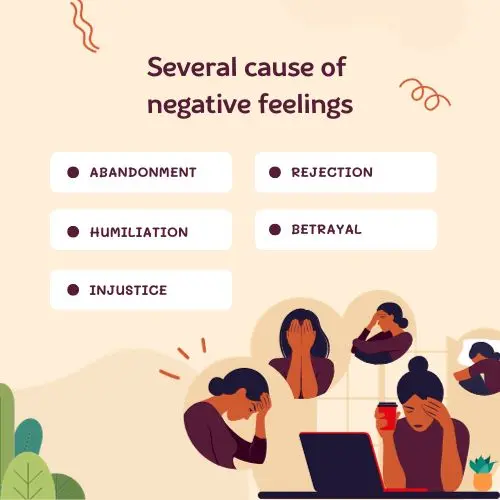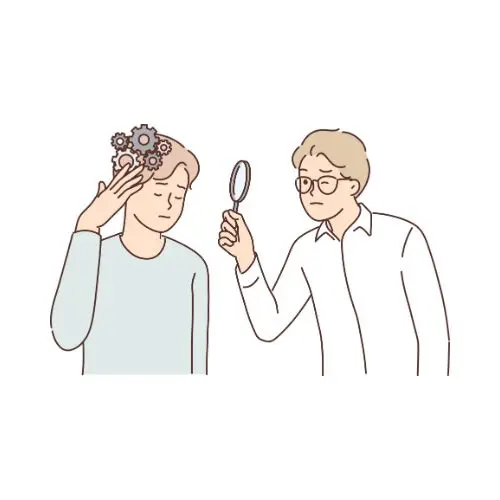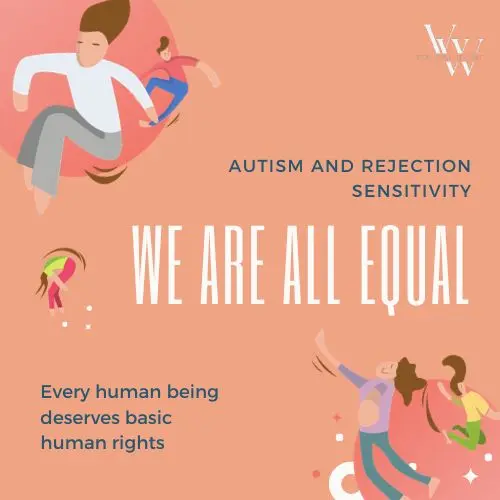Understanding Autism Spectrum Disorder: Core Characteristics and Challenges
Autism spectrum disorder (ASD) is a developmental disability that affects how a person communicates, interacts, behaves, and learns. People with ASD often have difficulties with social communication and interaction. They may also exhibit restricted or repetitive behaviours.
Rejection-sensitive dysphoria (RSD) is an intense emotional response to the perception of rejection or criticism. It is not officially recognized as a diagnosable condition, but many people on the autism spectrum report experiencing the symptoms of RSD.
Understanding the link between autism and RSD can help people on the spectrum manage difficult emotions and sensitivities. Here is a guide to everything you need to know about autism, RSD, and supporting autistic people who experience rejection sensitivity:
Step 1: Learn About Autism Spectrum Disorder

The main characteristics of ASD include:
- Social communication challenges – Difficulty with verbal and nonverbal communication, such as maintaining eye contact, reading social cues, and having back-and-forth conversations.
- Restrictive, repetitive behaviours – Rigid patterns of behaviour, interests, or activities, such as repetitive motor movements, inflexible routines, and highly fixated interests.
- Sensory issues – Hypersensitivity or undersensitivity to sensory input such as sound, touch, or taste. Seeking out or avoiding certain sensations.
- Cognitive differences – Variations in learning, attention, memory, problem-solving, planning, reasoning, flexibility. Around 50% have average to high intelligence.
- Co-occurring conditions – Many autistic individuals have other conditions such as ADHD, anxiety, depression, epilepsy, gastrointestinal issues, sleep disorders, etc.
The severity of ASD symptoms varies greatly across individuals. Some require substantial support, while others need less assistance to manage everyday life. Early intervention and support services can make a big difference in quality of life.
Step 2: Recognize Signs of Rejection Sensitive Dysphoria

Rejection-sensitive dysphoria involves intense emotional reactions to the feeling of rejection, criticism, or disapproval:
- Extreme emotional pain – Perceived rejection triggers sadness, anger, and humiliation that feel catastrophic and overwhelming.
- Pre-emptive defence mechanisms – Avoiding potential rejection by isolating socially, underachieving, dropping out, and substance abuse.
- ** Hypervigilance to criticism** – Highly sensitive and easily hurt by negative feedback. Feeling criticized even when no criticism was intended.
- Prolonged emotional recovery – Rejection triggers emotional wounds that take a long time to heal and recover from.
- Loss of self-esteem – Feeling worthless, defective, and unlovable after rejection. Self-esteem fluctuates drastically.
- Interpersonal sensitivity – Fearing others do not honestly care about them or will eventually reject them. Perceiving neutral interactions as dismissing.
RSD is not an official diagnosis but may warrant clinical attention when severe. It often co-occurs with conditions like ADHD, autism, anxiety disorders, depression, and bipolar disorder.
Step 3: Understand Why Autistics May Be Prone to RSD

Several factors can make people on the autism spectrum more vulnerable to developing RSD:
- Social communication challenges – Difficulty reading social cues and understanding others’ words/actions’ intent can lead to misperceived rejection or criticism where none was intended.
- Theory of mind differences – Autistics may struggle to infer others’ thoughts, feelings, and motivations. This makes it harder to understand others’ behaviour.
- Executive functioning challenges – Difficulties with cognitive flexibility, impulse control, and emotional regulation can make it harder for autistics to manage RSD reactions.
- Sensory sensitivities – Hypersensitivities to sensory stimuli like sound can also lead to sensitivities to emotional stimuli like rejection.
- Alexithymia – Many autistics have trouble identifying and describing their own emotions. This can lead to feeling emotionally overwhelmed.
- Mental health conditions – Anxiety, depression, and ADHD commonly co-occur with autism. These amplify emotional dysregulation and RSD.
- Trauma history – Bullying, exclusion, and discrimination many autistic face may contribute to fear of rejection and hypervigilance.
In essence, the neurobiology of autism can heighten sensitivity to rejection experiences, making RSD responses more intense and prolonged.
Step 4: Use Coping Strategies to Manage RSD

If you’re autistic and struggle with rejection sensitivity, there are strategies you can try to limit the intensity and duration of RSD episodes:
- Identify triggers – Reflect on situations that commonly trigger RSD so you can anticipate reactions. Develop plans to respond constructively.
- Breathing exercises – Slow, deep breathing can help calm the body’s stress response when facing criticism or rejection. Inhale for 4 seconds, exhale for 6.
- Distraction skills – Redirect your focus to something pleasant, like a favourite activity, book, or TV show, to take your mind temporarily off rejection.
- Thought challenging – Counter thoughts that amplify feelings of rejection. Ask yourself: is my perception accurate? Am I overgeneralizing?
- Self-care – Meet your physiological needs during RSD episodes – sleep, nutrition, hydration, movement or exercise.
- Support system – Having trusted people to confide in helps ease intense loneliness during RSD. Join autism support communities.
- Professional help – Seek counselling to work through past rejection trauma. Consult a doctor about medication if RSD is disabling.
Learning to anticipate and manage RSD takes practice but can significantly improve social and emotional well-being for autistics.
Step 5: How Family and Friends Can Provide Support

If you have a loved one who is autistic and experiences RSD, here are some ways to support them:
- Listen without judgement – Provide a safe space for them to share feelings without fear of rejection. Don’t invalidate their emotional reactions.
- Offer reassurance – Provide steady reminders of their value – highlighting talents, common interests, and shared memories.
- Model healthy social responses – Demonstrate thoughtful conflict resolution, forgiveness, and taking others’ perspectives.
- Gently challenge distortions – Point out other possible interpretations if they misperceive rejection.
- Allow time to recover – Respect their need for extra time and space to regulate emotions after feeling rejected.
- Suggest constructive outlets – Encourage journaling, exercise, and art as healthy ways to process complicated feelings.
- Watch for warning signs – Monitor for social withdrawal and depressive symptoms. Provide support accessing therapy if RSD becomes severe.
- Advocate against bullying – Use your privilege to stand up against the marginalization or mistreatment of autistic individuals.
With compassion and understanding, friends and family play a crucial role in creating a sense of belonging for autistics prone to rejection sensitivity.
Conclusion: Finding Connection Despite Vulnerability
The intersection between autism and rejection-sensitive dysphoria reflects human struggles for social connection, self-worth, and belonging. By learning to identify RSD triggers and implement coping strategies, autistic individuals can gain resiliency and emotional stability.
With the support of understanding friends and family, they can navigate social challenges while recognizing their inherent values and strengths. There are still struggles ahead, but with more excellent knowledge and empathy, we can create communities where differences are embraced, and everyone is seen as worthy of love and belonging.
Sources
CDC Autism Prevalence Statistics
Journal of Autism & Developmental Disorders study on RSD prevalence in autism
Autism Speaks General Autism Facts
Medical guide to co-occurring mental health issues in autism
Disclaimer:
- The information in this article is for informational purposes only and is not intended to be a substitute for professional medical advice, diagnosis, or treatment. Always seek the advice of your physician or other qualified healthcare provider with any questions you may have regarding a medical condition.
- References to studies, research, or articles do not imply endorsement by the author or organization. Information may contain opinions and viewpoints that differ from accepted standards. Readers are encouraged to evaluate findings critically and not rely solely on this content.
- Experiences with autism spectrum disorder and related conditions can vary significantly across individuals. The symptoms and challenges described here represent common presentations but do not apply to all people on the autism spectrum.
- The coping strategies discussed may not be suitable or practical for every person, and individual needs and responsiveness to support should always be considered. Consultation with medical or mental healthcare professionals is recommended when developing wellness plans.
- Friends and family members are encouraged to provide care, understanding and accommodation based on individual resources and capacity to the best of their abilities. But the ultimate responsibility for an autistic person’s well-being lies with that individual/their legal guardians.
- The author is not a licensed mental healthcare provider. Readers should verify all information presented by clinical experts as needed.

